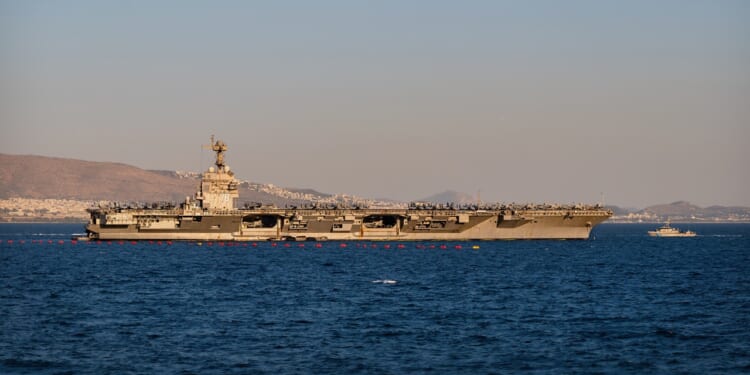The massive aircraft carrier is likely to play a role in any upcoming conflict with Iran, while staying well out of range of Tehran’s anti-ship missiles.
A dozen KC-135 Stratotankers belonging to the United States Air Force have been detected leaving the continental United States, transiting through Europe, and arriving at Al Udeid Airbase in Doha, Qatar. This is part of a larger US military buildup in the Middle East amidst rumors that the Israelis are preparing to restart their conflict with the Islamic Republic of Iran.
A fragile ceasefire enacted at the end of the 12-Day War in June is the only thing preventing those hostilities from restarting. And senior Israeli defense officials have already taken to the media to intimate that Israel “may need to act again,” as has been reported in The Jerusalem Post late last week.
The Geopolitics
Into this morass, the US Navy has moved its newest and largest aircraft carrier, the USS Gerald R. Ford (CVN-78). The supercarrier’s return to the Mediterranean Sea marks the first time an aircraft carrier has operated in the region since August. Most recently, the Ford took part in the third iteration of the Neptune Strike NATO exercises in the North Sea.
It is returning to the Mediterranean Sea after having previously been deployed there in June, during the 12-Day War. At that time, the Ford and its carrier strike group were deployed to the Mediterranean to offer President Donald Trump more military options, if the situation in the region called for it. Today, that is once again the Ford’s mission as it returns to the Mediterranean in the middle of the ongoing geopolitical breakdown.
Interestingly, the Americans are keeping the carrier in the Mediterranean, as opposed to deploying it closer to Iran. This is likely because, in spite of the Navy’s confident statements about the superiority of the Ford, there is real concern that Iranian anti-ship missiles—which went unused in the previous round of fighting in the Middle East—could eventually be used to swarm the carrier’s defenses and do significant damage.
Observers have already witnessed how Iranian-backed militants in Yemen, the Houthi rebels in the country’s north, stymied the US Navy throughout the post-October 7 era through a comprehensive strategy of area denial using Iranian-supplied missiles. By deploying to the Mediterranean and remaining out of the Gulf, if things pop off between Israel and Iran—and if Trump decides to intervene—the carrier will be able to deploy its warplanes without risking much in the way of Iranian anti-ship ballistic missiles successfully targeting the carrier.
The Airwing & the Failure of the F-35C
In terms of its warplanes, the carrier has a primary complement of F/A-18E/F Super Hornets. These are fourth-generation birds that were supposed to be replaced by the Navy’s fifth-generation Lockheed Martin F-35C Lightning II multirole fighter. Sadly, however, the ship’s Advanced Arresting Gear (AAG) cannot recover the F-35C upon landing, requiring it to rely on the Super Hornets for the near future.
That’s because the final design of the F-35C was still being developed when the Ford-class carriers were being finalized, leading to the current lack of full compatibility. The Navy is modifying the Ford and her new sister ships to be able to carry the F-35Cs, but this process will take years. So the F/A-18E/F Super Hornets are the main warplane on the carrier as it moves into the Mediterranean.
Along with Super Hornets, the Ford is carrying EA-18G Growlers for electronic warfare (EW) missions and suppression of enemy air defenses (SEAD). There are also E-2D Advanced Hawkeyes.
These aircraft provide all-weather airborne early warning and command and control. C-2A Greyhounds are turboprop aircraft providing carrier onboard delivery for logistical support. Then there are MH-60R and MH-60S Seahawk helicopters employed for anti-submarine warfare, anti-surface warfare, combat search-and-rescue, and logistics.
With these capabilities in the region, and with Jerusalem clamoring for renewed warfare with Tehran, should the Trump administration decide to intervene as they did with the B-2 Spirit long-range stealth bomber strikes on suspected Iranian nuclear weapons facilities during the last round of fighting, Trump will have options.
About the Author: Brandon J. Weichert
Brandon J. Weichert is a senior national security editor at The National Interest. Recently, Weichert became the host of The National Security Hour on America Outloud News and iHeartRadio, where he discusses national security policy every Wednesday at 8pm Eastern. He is also a contributor at Popular Mechanics and has consulted regularly with various government institutions and private organizations on geopolitical issues. Weichert’s writings have appeared in multiple publications, including The Washington Times, National Review, The American Spectator, MSN, The Asia Times, and others. His books include Winning Space: How America Remains a Superpower, Biohacked: China’s Race to Control Life, and The Shadow War: Iran’s Quest for Supremacy. His newest book, A Disaster of Our Own Making: How the West Lost Ukraine is available for purchase wherever books are sold. He can be followed via Twitter @WeTheBrandon.
Image: Shutterstock / a5hpek.


















